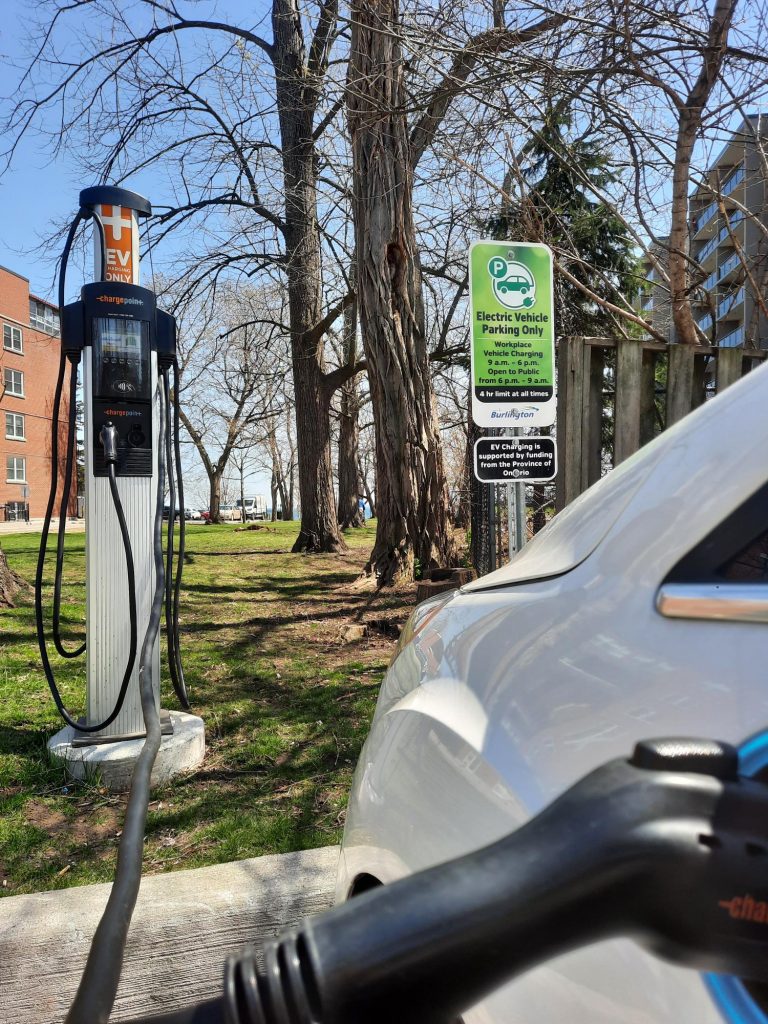How often you see an electric vehicle (EV) charging station in public space depends a lot on where you live. Perhaps surprisingly, Burlington, Ontario has more charging stations per capita than any other city in the GTHA, with over 30 public stations per 50,000 people (although this sounds small compared to the number we need to reach!) Toronto has about half that, with 16 stations per 50,000 people. Whether you live, work, or visit a city, it’s the difference between convenience and being stuck without power. We’ve seen how important charging access is to peoples’ willingness to purchase an EV — without reliable charging, you’re just not going to go electric.
Most GTHA municipalities with climate plans and targets identify vehicle electrification as a leading pathway to net-zero. Recognizing how critical the public charging network is for vehicle electrification, Burlington is making it a priority. With support from TAF’s EV Station Fund, the city is adding 16 additional public stations in the next year.
I interviewed Lynn Robichaud, Manager of Environmental Sustainability at the City of Burlington, about what it takes to lead on EV charging installation and management.
Why is the City of Burlington accelerating the installation of new EV charging stations?
City council declared a climate emergency in April 2019, and a year later approved the community Climate Action Plan with a target to be a net carbon neutral community by 2050. Support for electric mobility is a key program area in the Climate Action Plan. Council also approved the Corporate Energy and Emissions Management Plan in 2019 with a target for city operations (including the City’s fleet) to become net carbon neutral by 2040.
Can you tell us about the site locations and why they were chosen?
For this project we selected locations at some of our busiest community facilities, where the need will be highest as our community moves to EVs. Ensuring that parking spaces were available close to the building and that electrical infrastructure was suitable for connection were also factors in selecting these locations. The proposed new sites for charging stations include the Nelson Rec Centre, Mountainside Rec Centre, Mainway Rec Centre, Appleby Rec Centre, Tansley Woods Community Centre, and Haber/Norton Park.
What were the barriers to getting this project approved?
Council continues to support the expansion of EV charging stations on city property. Some of the tough questions were, what type and level of charging is required? How do we measure demand and report on usage? What are the criteria for city fleet vehicle charging vs public need and demand? How can we ensure equitable distribution across the city for different users (for example, accessible parking spots)? Staff are working on a corporate policy to help guide decisions related to the expansion of EV charging stations to make sure they’re as successful as possible. In addition, it’s very helpful to have a strong communications plan in place to engage council, senior management and the public on the benefits of supporting electric mobility, progress being made and highlight the links to climate action plans and targets. Share info, updates and photos with council members to include in their newsletters and social media feeds.
What does it take to be a leading municipality on EV charging?
Burlington adopted a green fleet strategy back in 2008 and has been working away at adding low and zero emission vehicles to its fleet. The city took advantage of a provincial funding program that was available a few years ago to support charging stations in the downtown area and continues to look for opportunities for funding, such as the TAF program, to expand EV charging infrastructure. In response to a staff update report on the city’s EV charging program, Council was clear that they were supportive, approving funding to continue to provide charging infrastructure. It’s also important for municipalities to share experiences and lessons learned with each other.
What are your hopes for this project?
The city is partnering with BurlingtonGreen, a local environmental organization, to develop a community based Electric Mobility Strategy to support the goal to become a net carbon neutral community by 2050. Although we recognize that active transportation and public transit must continue to be prioritized through the development of the Integrated Mobility Plan, supporting electric mobility must be part of the solution to reduce the overall community carbon footprint. The installation of additional EV charging stations will help make the decision much easier and build momentum for people to switch to electric vehicles. This project ensures a good distribution of EV charging infrastructure across city facilities, reduces range anxiety, and shows that Burlington is serious about taking action on climate change.
Of course, improving charging infrastructure is not a simple matter of adding more stations. Municipalities like Burlington who are investing in electrification are now reaping the rewards as more stations are added every year, giving them insights on how best to manage these critical pieces of infrastructure and serve their communities. TAF is thrilled to be working with the City of Burlington on this project, and to see more public charging stations being made available in the GTHA. With Canada’s target of having 100% light-duty vehicle sales be zero-emission by 2035, we hope to see other cities follow suit in building the infrastructure necessary to support the transition.


Photo credits: Header image by Dave Loretti on Flickr, EV chargers via City of Burlington.

